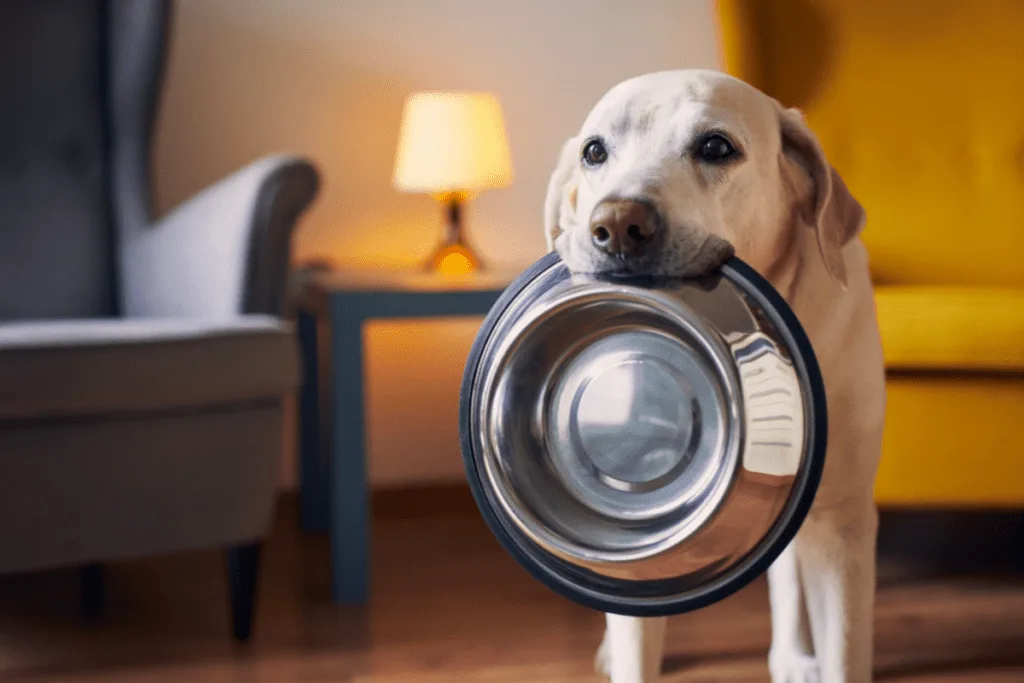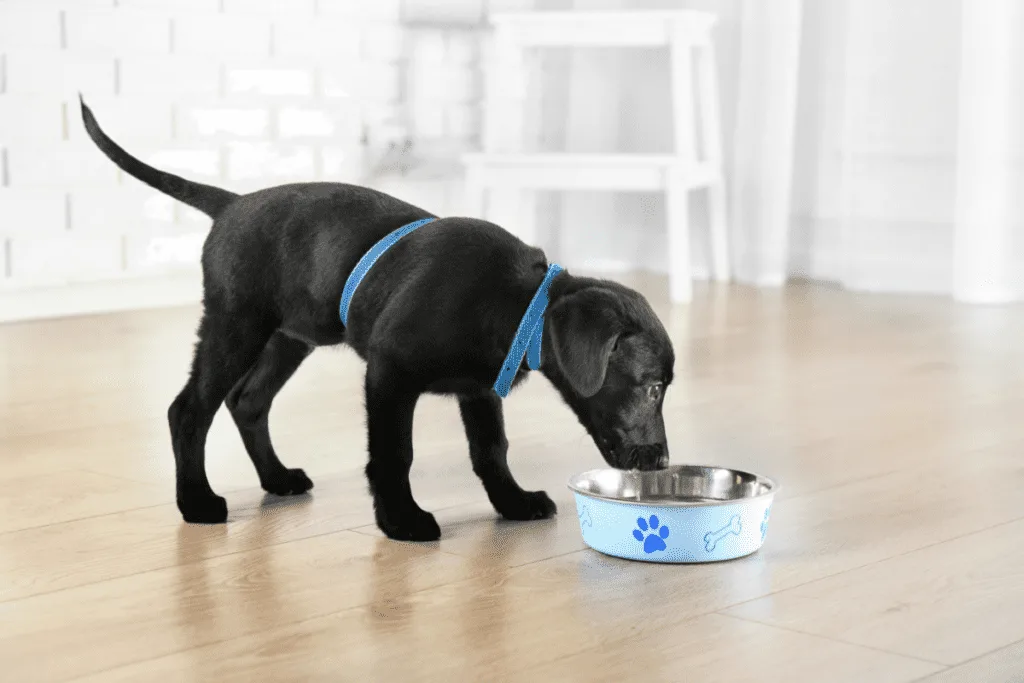As owners, you naturally want to best for your Labrador; nothing is more satisfying than a happy Labrador gleaming with good health!
However, choosing which food to feed your Labrador can be a daunting task when all the foods are marketed as the “best.”
Labradors need to be fed according to their age, size, metabolism, activity level, and health status; they should receive sufficient calories to maintain a body condition score of 3/5. The daily energy requirements of a Labrador are calculated as a factor of their resting energy requirements.
Amongst people, nutrition is a cornerstone of health, and the same is true for Labradors.
Whether your Labrador is healthy or struggling with a chronic or acute health challenge, nutrition is integral to good Labrador care and management.

What Factors Affect A Labrador’s Nutritional Requirements?
Each Labrador is unique, and the food that works well for one Labrador may not be the ideal food for another. Factors that affect a Labrador’s nutritional needs include:
- Age
- Size
- Metabolism and body condition
- Activity level
- Pregnancy and lactation
- Health conditions
Age
A Labrador’s life stage has a significant impact on the type of food they need. A young, rapidly growing Labrador requires a different nutrient profile, proportion, and chunk size than a senior Labrador living out their golden years.
The age factor is so influential that a large portion of this article will be dedicated to discussing feeding strategies and diet formulation according to the different life stages.
(Sources: VCA Hospital; National Research Council)
Size
The size factor is another variable that must be considered when choosing the best food for a Labrador.
The American Kennel Club (AKC) classifies the Labrador as a large breed dog, standing between 21.5″ to 24.5″ at the shoulder and weighing between 55lbs to 80lbs.
Toy dog breeds have smaller, weaker mouth structures and cannot chew and swallow large dog chunks. However, large dogs like Labradors tend to gulp and swallow (i.e., no chewing needed) small-dog food pellets; eating food too quickly can lead to dangerous health issues, e.g., bloat.
The Labradors size is also linked to the quantity of food fed and is calculated as a percentage of the dog’s optimal adult weight.
Labradors tend to have slower metabolisms than smaller dogs, and thus the percentage fed is lower than that of small dog breeds.
However, it takes more calories to sustain a Labrador than a chihuahua, so while the bodyweight percentage remains lower, the quantity of food is larger.
(Sources: MSD Manuel; DVM360)
Metabolism And Body Condition
A dog’s metabolism is influenced by its genetics (i.e., breed), gender, neutered vs. unneutered, activity level, and general health.
Few Labradors suffer from a fast metabolism; in fact, most Labradors have the opposite problem and have a life-long struggle with obesity.
While the teddy-bear look of a chubby Labrador is ultra-cute, it is not a healthy state for your Labrador to live in.
Many diets designed for Labradors, especially sedentary Labradors, have a calorie-restricted formulation to aid the Labrador in maintaining its optimal body condition.
(Sources: VCA Hospital)
Activity Level
While Labradors may be prone to packing on the pounds, they are an active breed that likes to play.
Labradors thrive as working dogs; many hunting enthusiasts pick Labradors for their superb performance as birding dogs.
Working Labradors and young, energetic Labradors have increased metabolic demands, which an increased calorie intake must meet.
Sedentary Labradors may need a calorie-restricted diet, but hard-working Labradors will need a higher calorie intake to match their activity level.
(Sources: National Research Council)
Pregnancy And Lactation
Pregnancy and lactation place a tremendous amount of stress on a female’s body. To successfully sustain a pregnancy and provide enough milk for her puppies, a Labrador female will need to increase her feed intake:
- Almost triple the amount of protein
- Double the amount of fats
- Double the number of calories, this will need to be increased even more for females with large litters
- Different minerals and vitamins
A breeding Labrador’s diet should be chosen and formulated under veterinary supervision as the female’s diet affects her health and her puppies’ current and future health.
(Sources: National Research Council)
Health Conditions
A Labrador’s diet may be directly or indirectly linked to several different health conditions.
Obesity-linked health conditions are indirectly related to diet, e.g., a Labrador’s excess weight places unnecessary stress on its joints leading to the development of arthritis.
Health conditions directly linked to a Labrador’s diet include diabetes, inflammatory bowel disease, pancreatitis, and other conditions. The primary treatment in many of these conditions is diet modification.
(Sources: VCA Hospital)
Feeding Your Labrador: General Guidelines

There are a few basic feed guidelines that apply to all Labrador’s regardless of their needs:
Frequency Of Feeding And Division Of Daily Amounts
Vets, dog food manufacturers, and scientists have developed various formulas to calculate the amount of food and calories needed to feed a Labrador.
However, the recommended amount should not be fed in a single serving.
Instead, the recommended daily amount should be split between two feeds or more depending on the Labrador’s age.
The Labrador’s feed should always be measured out and fed according to weight and not volume.
(Sources: AKC)
Fresh Food And Water
Your Labrador should have access to an unlimited supply of fresh water.
Ideally, the bowl should have a stabilizing rim that prevents the water-loving Labrador from tipping over its water bowl while playing.
It may be tempting to give your Labrador access to a free-feeder system that you only fill once or twice a week; however, this leaves your Labrador vulnerable to the dangers of compromised food.
The high fat and protein content in dog food causes it to become rancid if left out in the open; even dry dog food will quickly go off if exposed to the elements.
Feeding strictly controlled quantities of fresh food every day allows you to:
- Monitor your Labrador’s appetite and quickly respond to any changes in appetite; changes in appetite can be an indication of illness, injury, or other health issues
- Control your Labrador’s weight
Hygiene And Storage
Dry food should be stored in a metal or plastic air-tight container in the house, garage, or barn. Ideally, dry food should be fed within 3 weeks of opening the bag.
According to the manufacturer’s instructions, wet food needs to be stored in a fridge or cool dark cupboard before opening it.
Once opened, canned wet food should be stored in the refrigerator and fed within 3 days.
Cooked and raw food must be frozen and kept in the freezer, only being defrosted on the same day it is fed.
Your Labrador’s food bowl must be cleaned after each meal, preferably with hot water and soap, while the water bowl should be thoroughly cleaned at least once a day.
Calm, Controlled Feeding
Many owners are surprised to discover that HOW you feed your Labrador is just as important as WHAT you feed your Labrador.
Teaching your Labrador to calmly and patiently wait for their food is an excellent training exercise.
This exercise teaches your Labrador to be polite around food and keep his focus on you, even when faced with the tempting distraction of food!
Over-excited Labradors are more likely to choke or develop bloat and torsion if they:
- Eat to quickly
- Are active an hour before or after eating
These issues can be prevented by:
- Feeding your Labrador in a slow-feeder bowl, like this one or this one.
- Feeding your Labrador by itself, without other dogs around. Dogs who are afraid that another dog will steal their food tend to eat faster.
- Feed your Labrador smaller meals
- Crate-train your Labrador or keep them locked in a room for 30 minutes before and after eating. The midwest folding crate is the ideal feeding crate for a hyperactive Labrador.
Labrador Feeding Guide According To Age
A Labrador’s dietary needs will vary according to their life stage and the primary physiological processes associated with different Labrador age groups.
Newborn Labradors: Birth to 12 weeks

Puppies are immature at birth, and their digestive systems cannot utilize the food we feed adult dogs. The best food for a newborn puppy is their mom’s milk.
Puppy milk formula and puppy mousse (i.e., a pre-digested soft food) are used to supplement puppies in large litters and orphaned puppies.
At 3 to 4 weeks, breeders will start introducing their puppies to hard feed, which has been softened with water and turned into a mash.
At this stage, puppies will need to eat 4 to 6 times per day.
Young puppies need to eat a lot, but their stomachs and gastrointestinal tracts can’t handle large meals. The solution is small meals, fed frequently throughout the day.
Responsible breeders will allow their puppies to go to their new homes at 10 weeks. The new owners should slowly transition their puppy to their preferred brand of puppy food over 2 weeks.
(Sources: VCA Hospital; National Research Council)
Labrador Puppies: 12 weeks to 6 months

Labrador puppies grow like weeds, and it takes a significant number of calories to support their rapid growth; however, too much food can have unintended consequences.
Labrador puppies who are overfed are more likely to develop obesity-linked complications and orthopedic health problems later in life.
Over-feeding can be just as detrimental to your Labrador’s health as underfeeding.
Most high-quality Labrador feeds have a feeding chart that will indicate the amount you should feed your Labrador based on their estimated adult weight.
However, this chart is a guideline and should not be regarded as an absolute, each Labrador is different, and the amounts fed need to honor their individuality.
As your Labrador’s digestive system matures, they will cope better with slightly larger feeds and decreased feeding frequency.
Most Labrador puppies will cope fine with 3 to 4 meals per day which are gradually reduced to 2 feeds per day by 6 months.
One of the most critical minerals included in a young Labrador’s diet is calcium. Calcium is essential for healthy bone growth, but too much calcium can cause dietary imbalances.
Ideally, a Labrador puppy’s food should be complete and not require any supplementation. High-quality large breed puppy foods should contain:
- Minimum 30% high-quality protein
- 9% Fat; animal fat is a better source of fat for puppies than vegetable oils
- 1:1 to 1:3 Calcium-Phosphorous ratio
- 1.5% (i.e. 3g per 1000 Kilocalories) Calcium content
- Optimal levels of vitamin D, vitamin A, copper, manganese, and zinc
(Sources: VCA Hospital; National Research Council)
Labrador Juveniles: 6 months to 12 months

Many owners are unsure whether to feed their juvenile Labradors for maximal growth or optimal growth.
Ideally, juvenile Labradors should be fed for optimal growth, i.e., slow, steady growth rate.
Labrador diets, which promote a slow, steady growth, will not stunt the dog’s final size.
A “maximal growth” diet allows a dog to achieve its final height at an earlier age, but this early growth comes at the cost of its health.
An “optimal growth” diet ensures that the dog attains its maximum adult size without compromising its health.
According to Waltham’s scientifically formulated growth charts, most large breed dogs, like the Labrador, will achieve their final height at approximately 9 months and their final weight shortly after their first birthday.
Veterinarians recommend that juvenile Labrador’s be fed a transitional diet during their teenage years
Towards the end of their first year, Labradors can be gradually introduced to adult food.
(Source: VCA Hospital)
Adult Labradors

Adult dogs are fed a “maintenance” diet.
This diet is not suitable for growing puppies, lactating or pregnant females, senior dogs, or dogs struggling with a health condition. Instead, this diet focuses on maintaining the health of a relatively healthy dog.
Many owners equate their love with the amount of food they give their Labrador. Although the sentiment is good, using your heart to make a scientific decision rarely goes well!
When determining how much to feed your Labrador, it is better to evaluate your Labrador’s body condition and general demeanor rather than the amount of food in their bowl.
How Do Vets Calculate How Much To Feed An Adult Labrador
The resting energy requirement (RER) is the amount of energy a Labrador requires when resting in a controlled environment.
RER is calculated as:
(Body weight (kg) x 30) + 70 = kilocalories need per day
To convert from pounds to kgs:
Body weight (lbs)/2.2 = Body weight (kgs)
The daily energy requirement (DER) is calculated as a factor of the resting energy requirement:
| Factors Affecting DER | Calculating DER |
| Neutered Adult | 1.6 x RER |
| Intact Adult | 1.8 x RER |
| Obesity-Prone Adult | 1.4 x RER |
| Weight-loss Diet | 1.0 x RER (although some vets may calculate it as 0.9 x RER) |
| Labradors doing light work | 2.0 x RER |
| Labradors doing hard work | 4 to 8 x RER (it’s unusual to find a Labrador in this category) |
Table 1: Calculating a Labrador’s Daily Energy Requirements
(Sources: DVM360; VCA Hospital)
Why Is Your Labrador’s Body Condition Score Important?
A body condition score is the dog’s equivalent of the human Body-Mass Index. Two body condition scores may be used: 0 to 5 and 0 to 9.
Both scales range from severe emaciation to morbid obesity, but the 9-point scale offers more insight into subtle nuances affecting a Labrador’s weight.
The ideal weight for a Labrador is 3/5 or 5/9, in which the ribs, spine, and pelvis are covered with a layer of fat but can still be easily felt. These Labradors should have a gently defined waist and tummy tuck.
RER and DER offer insight into the recommended calorie intake for Labradors; however, the body condition score allows you to fine-tune a Labrador’s calorie intake based on the outcome of the recommended diet plan.
Labradors who gain too much weight may need to be fed less than the recommended amount, while Labradors who lose weight will need to be fed more.
(Sources: VCA Hospital)
Senior Labradors
As Labradors age, they become more sedentary and begin the battle with middle-age spread.
In addition to these changes, many senior Labradors struggle with chronic health conditions.
Labradors are transitioned to “Senior” foods between 7 to 9 years, depending on their general health.
Senior Labrador diets are formulated to have:
- Fewer calories, i.e., 20% fewer calories than an adult maintenance diet
- Higher protein, i.e., 28% to 32%. Senior Labradors need 50% more protein than other adult Labradors
- Lower sodium and phosphorous to protect the heart and kidneys
- Increased omega-3 fatty acids, glucosamine, and other anti-inflammatory ingredients designed to support aging joints and prevent cognitive decline
Feeding A Senior Labrador Who Is A Fussy Eater
Many older Labradors can become fussy eaters. It is essential to ensure that your Labrador is:
- Allowed to eat in a comfortable position
- Fed palatable foods
As your Labrador ages, they may develop arthritis which can make certain eating positions difficult.
Raising your Labrador’s bowl to their knee height allows Labradors with neck and front leg arthritis to eat comfortably.
You can raise your Labrador’s bowl by placing it on the bottom step of a staircase, low stool, or in a bowl-stand.
A good bowl-stand that we don’t hesitate to recommend is the IRIS Large Plastic Elevated Feeder. It’s simply designed and does the job that it was made for well.
Each dog will have its food preferences; it may take some experimentation to find a brand of food that your Labrador is happy to eat.
Labradors who refuse to eat for more than one meal need to be seen by a Veterinarian.
(Sources: AKC; VCA Hospital)
Judging The Quality Of Your Labrador’s Food
The difference between high-priced high-quality food and budget food is not always immediately apparent, especially in heavily processed dry foods.
Ideally, dog foods should list the micro-and macro-nutrient contents and the whole food ingredients used in the food.
Dog food companies have learned to “hide” low-quality ingredients by using complicated scientific terminology that few pet owners understand.
The best way to ensure your Labrador receives the optimal food is to speak to your veterinarian or canine nutritionist, who can advise you on which locally available foods are ideal for your Labrador.
(Sources: VCA Hospital)
Health Conditions Linked To An Unbalanced Labrador Diet
Most Labrador owners are aware of the dangers of feeding their dogs too much or too little; however, few owners are aware of the issues relating to malnutrition.
Dietary deficiencies and imbalances cause malnutrition, and even Labradors at their ideal weight may struggle with malnutrition.
Symptoms of malnutrition include:
- Fur loss and poor coat quality
- Fatigue/lethargy
- Poor responsiveness
- Altered neuromuscular performance
- Other symptoms which are linked to specific nutrient deficiencies or over-supplementation
Malnutrition can cause serious health complications such as anemia, rickets, and other developmental orthopedic diseases.
In pregnant bitches’ malnutrition can cause miscarriage, birth complications, and developmental deformities in the puppies.
(Sources: The Canadian Veterinary Journal; Merck Vet Manual)
What Causes Malnutrition In Labradors?
Malnutrition may be caused by unbalanced diets (this is frequently seen in home-formulated raw food diets), internal parasites, and digestive conditions affecting the uptake and utilization of nutrients.
If your Labrador shows any signs of illness or failure to thrive, take them to a veterinarian, even if they are a healthy weight.
Most high-quality off-the-shelf commercial foods are formulated to be “complete” foods, containing all the nutrients, minerals, and vitamins necessary to ensure your Labrador remains in perfect health.
However, in cases where the malnutrition is caused by an allergy or disease condition (e.g., inflammatory bowel disease), a prescription or custom diet may be required to address the malnutrition.
(Sources: The Canadian Veterinary Journal; Merck Vet Manual)
Health Conditions Which Are Managed Through Diet
There are many diseases such as diabetes mellitus, pancreatitis, renal failure, and many other conditions which are managed through diet.
According to the health condition being managed, your vet will either recommend an off-the-shelf prescription diet or a scientifically formulated home-cooked diet for your Labrador.
Final Thoughts
Nutrition is one of the fundamental principles to master in your Labrador’s day-to-day care. What you feed your Labrador today affects their current health, as well as their future health and longevity.
So take the time to thoughtfully approach how you feed your lab – you and your pup will be happy you did!
